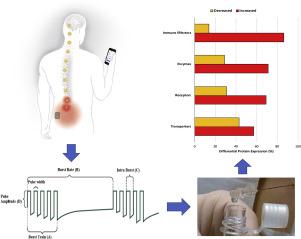当前位置:
X-MOL 学术
›
J. Neuroimmunol.
›
论文详情
Our official English website, www.x-mol.net, welcomes your
feedback! (Note: you will need to create a separate account there.)
Examination and characterisation of burst spinal cord stimulation on cerebrospinal fluid cellular and protein constituents in patient responders with chronic neuropathic pain - A Pilot Study
Journal of Neuroimmunology ( IF 2.9 ) Pub Date : 2020-07-01 , DOI: 10.1016/j.jneuroim.2020.577249 Jonathan Royds 1 , Melissa J Conroy 2 , Margaret R Dunne 2 , Hilary Cassidy 3 , David Matallanas 3 , Joanne Lysaght 2 , Connail McCrory 1
Journal of Neuroimmunology ( IF 2.9 ) Pub Date : 2020-07-01 , DOI: 10.1016/j.jneuroim.2020.577249 Jonathan Royds 1 , Melissa J Conroy 2 , Margaret R Dunne 2 , Hilary Cassidy 3 , David Matallanas 3 , Joanne Lysaght 2 , Connail McCrory 1
Affiliation

|
INTRODUCTION
Patients with neuropathic pain have altered proteomic and neuropeptide constituents in cerebrospinal fluid (CSF) compared to controls. Tonic spinal cord stimulation (SCS) has demonstrated differential expression of neuropeptides in CSF before and after treatment suggesting potential mechanisms of action. Burst-SCS is an evidence-based paraesthesia free waveform utilised for neuropathic pain with a potentially different mechanistic action to tonic SCS. This study examines the dynamic biological changes of CSF at a cellular and proteome level after Burst-SCS. METHODS
Patients with neuropathic pain selected for SCS had CSF sampled prior to implant of SCS and following 8 weeks of continuous Burst-SCS. Baseline and 8-week pain scores with demographics were recorded. T cell frequencies were analysed by flow cytometry, proteome analysis was performed using mass spectrometry and secreted cytokines, chemokines and neurotrophins were measured by enzyme-linked immunosorbent assay (ELISA). RESULTS
4 patients (2 females, 2 males) with a mean age of 51 years (+/-SEM 2.74, SD 5.48) achieved a reduction in pain of >50% following 8 weeks of Burst-SCS. Analysis of the CSF proteome indicated a significant alteration in protein expression most related to synapse assembly and immune regulators. There was significantly lower expression of the proteins: growth hormone A1 (PRL), somatostatin (SST), nucleobindin-2 (NUCB2), Calbindin (CALB1), acyl-CoA binding protein (DBI), proSAAS (PCSK1N), endothelin-3 (END3) and cholecystokinin (CCK) after Burst-SCS. The concentrations of secreted chemokines and cytokines and the frequencies of T cells were not significantly changed following Burst-SCS. CONCLUSION
This study characterised the alteration in the CSF proteome in response to burst SCS in vivo. Functional analysis indicated that the alterations in the CSF proteome is predominately linked to synapse assembly and immune effectors. Individual protein analysis also suggests potential supraspinal mechanisms.
中文翻译:

检查和表征突发脊髓刺激对慢性神经性疼痛患者的脑脊液细胞和蛋白质成分的影响 - 一项初步研究
引言 与对照组相比,患有神经性疼痛的患者脑脊液 (CSF) 中的蛋白质组和神经肽成分发生了改变。强直性脊髓刺激 (SCS) 已证明治疗前后脑脊液中神经肽的差异表达表明了潜在的作用机制。Burst-SCS 是一种基于证据的无感觉异常波形,用于神经性疼痛,其机制作用可能与强直性 SCS 不同。本研究在细胞和蛋白质组水平上检查了 Burst-SCS 后脑脊液的动态生物学变化。方法 选择用于 SCS 的神经性疼痛患者在 SCS 植入前和 8 周连续 Burst-SCS 后采集 CSF 样本。记录基线和 8 周疼痛评分与人口统计学。通过流式细胞术分析 T 细胞频率,使用质谱法进行蛋白质组分析,并通过酶联免疫吸附测定 (ELISA) 测量分泌的细胞因子、趋化因子和神经营养因子。结果 4 名平均年龄为 51 岁(+/-SEM 2.74,SD 5.48)的患者(2 名女性,2 名男性)在 Burst-SCS 的 8 周后实现了>50% 的疼痛减轻。CSF 蛋白质组分析表明,与突触组装和免疫调节剂最相关的蛋白质表达发生了显着变化。蛋白质的表达显着降低:生长激素 A1 (PRL)、生长抑素 (SST)、核结合蛋白-2 (NUCB2)、钙结合蛋白 (CALB1)、酰基辅酶 A 结合蛋白 (DBI)、proSAAS (PCSK1N)、内皮素-3 Burst-SCS 后 (END3) 和胆囊收缩素 (CCK)。Burst-SCS后分泌的趋化因子和细胞因子的浓度以及T细胞的频率没有显着变化。结论 本研究表征了响应体内爆发性 SCS 的 CSF 蛋白质组变化。功能分析表明,脑脊液蛋白质组的改变主要与突触组装和免疫效应物有关。个别蛋白质分析也表明了潜在的脊髓上机制。
更新日期:2020-07-01
中文翻译:

检查和表征突发脊髓刺激对慢性神经性疼痛患者的脑脊液细胞和蛋白质成分的影响 - 一项初步研究
引言 与对照组相比,患有神经性疼痛的患者脑脊液 (CSF) 中的蛋白质组和神经肽成分发生了改变。强直性脊髓刺激 (SCS) 已证明治疗前后脑脊液中神经肽的差异表达表明了潜在的作用机制。Burst-SCS 是一种基于证据的无感觉异常波形,用于神经性疼痛,其机制作用可能与强直性 SCS 不同。本研究在细胞和蛋白质组水平上检查了 Burst-SCS 后脑脊液的动态生物学变化。方法 选择用于 SCS 的神经性疼痛患者在 SCS 植入前和 8 周连续 Burst-SCS 后采集 CSF 样本。记录基线和 8 周疼痛评分与人口统计学。通过流式细胞术分析 T 细胞频率,使用质谱法进行蛋白质组分析,并通过酶联免疫吸附测定 (ELISA) 测量分泌的细胞因子、趋化因子和神经营养因子。结果 4 名平均年龄为 51 岁(+/-SEM 2.74,SD 5.48)的患者(2 名女性,2 名男性)在 Burst-SCS 的 8 周后实现了>50% 的疼痛减轻。CSF 蛋白质组分析表明,与突触组装和免疫调节剂最相关的蛋白质表达发生了显着变化。蛋白质的表达显着降低:生长激素 A1 (PRL)、生长抑素 (SST)、核结合蛋白-2 (NUCB2)、钙结合蛋白 (CALB1)、酰基辅酶 A 结合蛋白 (DBI)、proSAAS (PCSK1N)、内皮素-3 Burst-SCS 后 (END3) 和胆囊收缩素 (CCK)。Burst-SCS后分泌的趋化因子和细胞因子的浓度以及T细胞的频率没有显着变化。结论 本研究表征了响应体内爆发性 SCS 的 CSF 蛋白质组变化。功能分析表明,脑脊液蛋白质组的改变主要与突触组装和免疫效应物有关。个别蛋白质分析也表明了潜在的脊髓上机制。











































 京公网安备 11010802027423号
京公网安备 11010802027423号